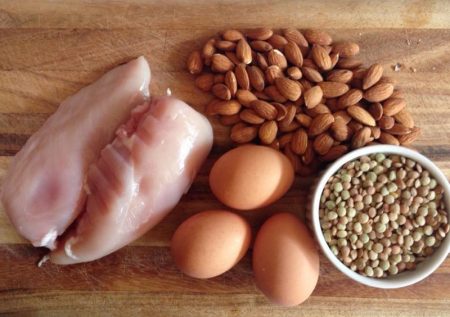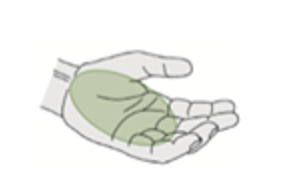Proteins are the building blocks of muscles and organs. You need proteins to help your baby grow.
When you eat them with your carbohydrates, proteins slow down digestion and can help insulin work better. If you pay attention to your fullness, you will feel fuller faster. This can help you avoid overeating.
Proteins can come from animal sources and from plant sources.
Plant proteins are really healthy. Food from plant sources is low in ‘less healthy’ fats. It is good to include a good amount of plant-based protein in your diet. However, you do not have to be a vegetarian to be healthy. There are healthy ways to eat animal proteins. If you are vegetarian, while this can be a healthy way of eating, you need to make sure you are getting all your vitamins and minerals.
Remember though that legumes contain both protein and carbohydrates (see healthy plate).

GDM Nutrition Basics: Proteins

Audio Only
Poultry, meat, fish, and seafood contain ‘animal proteins.’
Fish and seafood also have a lot of ‘good fat’ (omega-3s).
To make poultry and meat healthier, the key is to remove the ‘unhealthy fat’ and to cook in a way to not make fats unhealthier.
TIPS:
- Choose lean meats and poultry
- Bake, grill or roast instead of frying (which increases fat) or breading (which increases carbohydrates).
- Remove visible fats from meats and poultry, when possible.
- Eat skinless poultry as the skin contains unhealthy fats.
- Choose low-fat dairy options over full-fat alternatives (examples: low-fat yogurt, low-fat milk and low-fat cheese).
- Be careful: Some low-fat products have high sugar content (eg. Low fat peanut butter). Don’t trade fat for sugar!
Legumes, nuts and seeds and soy products have a lot of plant protein.
Here are some helpful tips to increase the amount of plant protein you are eating:
- Add beans, lentils or chickpeas to your salads and soups. Don’t forget to consider the carbohydrate content of those foods when planning your plate.
- Tofu can replace animal proteins in many recipes
- If you are vegetarian and want to avoid animal products, drink soy milk instead of almond, rice and coconut milks.
Do you bloat with beans? Some tips:
- Soak your beans in triple amount of water, for at least eight hours to reduce the amount of the substance that can cause gas production in your gut.
- Throw away the water used for soaking.
- Drain and rinse your beans very well.
- Cook them in fresh water and make sure you remove the foam that forms on the surface when the water reaches boiling point.
- If you are not used to eating beans and legumes, start eating them in small amounts to give time to adjust, and then increase gradually.
How much protein should you be consuming?
Use the palm of your hand to estimate portion size of protein. We can consider the palm to equal two servings. Aim for the equivalent of four to five palm-sized portions each day.
Breakfast – 1 serving (half a palm)
Snack – 1 serving (half a palm)
Lunch – 2 to 3 servings (1 to 1-1/2 palms)
Snack – 1 serving (half a palm)
Dinner – 2 to 3 servings (1 to 1-1/2 palms)
Snack — 1 serving (half a palm)
This adds up to 4 to 5 palm-sized portions per day.


